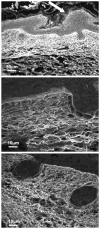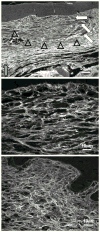Scarless fetal wound healing: a basic science review
- PMID: 20885241
- PMCID: PMC4229131
- DOI: 10.1097/PRS.0b013e3181eae781
Scarless fetal wound healing: a basic science review
Abstract
Scar formation is a major medical problem that can have devastating consequences for patients. The adverse physiological and psychological effects of scars are broad, and there are currently no reliable treatments to prevent scarring. In contrast to adult wounds, early gestation fetal skin wounds repair rapidly and in the absence of scar formation. Despite extensive investigation, the exact mechanisms of scarless fetal wound healing remain largely unknown. For some time, it has been known that significant differences exist among the extracellular matrix, inflammatory response, cellular mediators, and gene expression profiles of fetal and postnatal wounds. These differences may have important implications in scarless wound repair.
Conflict of interest statement
Figures




References
-
- Colwell AS, Phan TT, Kong W, et al. Hypertrophic scar fibroblasts have increased connective tissue growth factor expression after transforming growth factor-beta stimulation. Plast Reconstr Surg. 2005;116:1387–1390. - PubMed
-
- Rowlatt U. Intrauterine healing in a 20-week human fetus. Virchows Arch. 1979;381:353–361. - PubMed
-
- Adzick NS, Longaker MT. Characteristics of Fetal Tissue Repair. New York: Elsevier; 1992.
-
- Lane AL. Human fetal skin development. Pediatr Dermatol. 1986;3:487–491. - PubMed
Publication types
MeSH terms
Grants and funding
LinkOut - more resources
Full Text Sources
Other Literature Sources
Medical

